
A barge is a flat-bottomed ship, built mainly for river and canal transport of heavy goods. Some barges are not self-propelled and must be towed or pushed by towboats, canal barges or towed by draft animals on an adjacent towpath. Barges contended with the railway in the early Industrial Revolution, but were outcompeted in the carriage of high-value items due to the higher speed, falling costs and route flexibility of railways.

Canals, or navigations, are human-made channels, or artificial waterways, for water conveyance, or to service water transport vehicles.
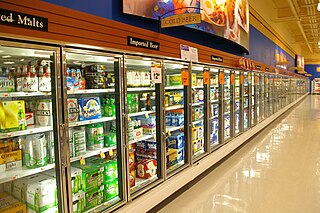
Refrigeration is a process of removing heat from a low-temperature reservoir and transferring it to a high-temperature reservoir. The work of heat transfer is traditionally driven by mechanical means, but can also be driven by heat, magnetism, electricity, laser, or other means. Refrigeration has many applications, including, but not limited to: household refrigerators, industrial freezers, cryogenics, and air conditioning. Heat pumps may use the heat output of the refrigeration process, and also may be designed to be reversible, but are otherwise similar to air conditioning units.

A cargo ship or freighter ship is a merchant ship that carries cargo, goods, and materials from one port to another. Thousands of cargo carriers ply the world's seas and oceans each year, handling the bulk of international trade. Cargo ships are usually specially designed for the task, often being equipped with cranes and other mechanisms to load and unload, and come in all sizes. Today, they are almost always built by welded steel, and with some exceptions generally have a life expectancy of 25 to 30 years before being scrapped.

The canals of the United Kingdom are a major part of the network of inland waterways in the United Kingdom. They have a colourful history, from use for irrigation and transport, through becoming the focus of the Industrial Revolution, to today's role of recreational boating. Despite a period of abandonment, today the canal system in the United Kingdom is again in increasing use, with abandoned and derelict canals being reopened, and the construction of some new routes. Most canals in England and Wales are maintained by the Canal & River Trust, previously British Waterways, but a minority of canals are privately owned.

The Canal Saint-Martin is a 4.6 km long canal in Paris, connecting the Canal de l'Ourcq to the river Seine. Over nearly half its length, between the Rue du Faubourg du Temple and the Place de la Bastille, it was covered, in the mid-19th century, to create wide boulevards and public spaces on the surface. The canal is drained and cleaned every 10–15 years, and it is always a source of fascination for Parisians to discover curiosities and even some treasures among the hundreds of tonnes of discarded objects.
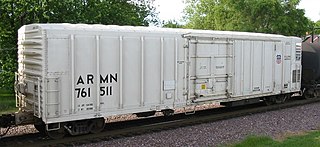
A refrigerator car is a refrigerated boxcar (U.S.), a piece of railroad rolling stock designed to carry perishable freight at specific temperatures. Refrigerator cars differ from simple insulated boxcars and ventilated boxcars, neither of which are fitted with cooling apparatus. Reefers can be ice-cooled, come equipped with any one of a variety of mechanical refrigeration systems, or utilize carbon dioxide as a cooling agent. Milk cars may or may not include a cooling system, but are equipped with high-speed trucks and other modifications that allow them to travel with passenger trains.
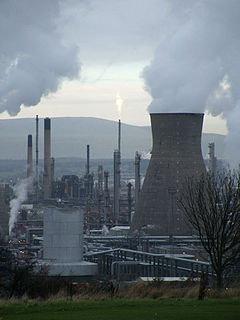
Petroleum products are materials derived from crude oil (petroleum) as it is processed in oil refineries. Unlike petrochemicals, which are a collection of well-defined usually pure chemical compounds, petroleum products are complex mixtures. The majority of petroleum is converted to petroleum products, which includes several classes of fuels.
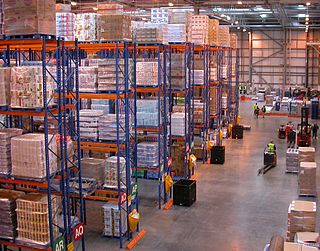
A distribution center for a set of products is a warehouse or other specialized building, often with refrigeration or air conditioning, which is stocked with products (goods) to be redistributed to retailers, to wholesalers, or directly to consumers. A distribution center is a principal part, the order processing element, of the entire order fulfillment process. Distribution centers are usually thought of as being demand driven. A distribution center can also be called a warehouse, a DC, a fulfillment center, a cross-dock facility, a bulk break center, and a package handling center. The name by which the distribution center is known is commonly based on the purpose of the operation. For example, a "retail distribution center" normally distributes goods to retail stores, an "order fulfillment center" commonly distributes goods directly to consumers, and a cross-dock facility stores little or no product but distributes goods to other destinations.

A dry bulk cargo barge is a barge designed to carry freight such as coal, finished steel or its ingredients, grain, sand or gravel, or similar materials. Barges are usually constructed of steel. They have an outer hull, an internal void that is fitted with heavy struts and cross braces or scantlings, and an internal cargo box. The outer hull of a barge can come in one of two configurations. A rake barge has a curved bow to provide less resistance when being pushed and is usually placed at the head of the tow. A box barge is usually placed in the center and rear of the tow and can hold more cargo.

Rail freight transport is the use of railroads and trains to transport cargo as opposed to human passengers.

Bulk cargo is commodity cargo that is transported unpackaged in large quantities. It refers to material in either liquid or granular, particulate form, as a mass of relatively small solids, such as petroleum/crude oil, grain, coal, or gravel. This cargo is usually dropped or poured, with a spout or shovel bucket, into a bulk carrier ship's hold, railroad car/railway wagon, or tanker truck/trailer/semi-trailer body. Smaller quantities can be boxed and palletised. Bulk cargo is classified as liquid or dry.
Lightering is the process of transferring cargo between vessels of different sizes, usually between a barge and a bulker or oil tanker. Lightering is undertaken to reduce a vessel's draft in order to enter port facilities which cannot accept very large ocean-going vessels. Lightering can also refer to the use of a lighter barge for any form of short-distance transport, such as to bring railroad cars across a river. In addition, lightering can refer to the process of removing oil or other hazardous chemicals from a compromised vessel to another vessel to prevent oil from spilling into the surrounding waters.

The Port of Sacramento, now known as the Port of West Sacramento, is an inland port in West Sacramento, California in the Sacramento metropolitan area. It is 79 nautical miles (146 km) northeast of San Francisco, and is centered in the California Central Valley, one of the richest agricultural regions in the world.

The Port of Le Havre is the Port and port authority of the French city of Le Havre. It is the second-largest commercial port in France in terms of overall tonnage, and the largest container port, with three sets of terminals. It can accommodate all sizes of world cruise liners, and a major new marina is being planned. Le Havre is linked to Portsmouth, England, by Brittany Ferries.
The Port of Constanța is located in Constanța, Romania, on the western coast of the Black Sea, 179 nautical miles (332 km) from the Bosphorus Strait and 85 nmi (157 km) from the Sulina Branch, through which the Danube river flows into the sea. It covers 3,926 ha, of which 1,313 ha is land and the rest, 2,613 ha is water. The two breakwaters located northwards and southwards shelter the port, creating the safest conditions for port activities. The present length of the north breakwater is 8.344 m (27.38 ft) and the south breakwater is 5.560 m (18.24 ft). The Port of Constanța is the largest on the Black Sea and the 17 th largest in Europe.
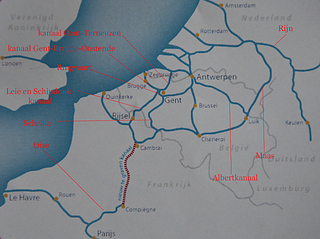
The Seine–Nord Europe Canal is a projected high-capacity canal in France that would link the Oise River at Compiègne with the Canal Dunkerque-Escaut, east of Arleux. The objective is to expand trade flows in a fuel-efficient and ecologically friendly manner between the Seine basin and Belgium, Germany and the Netherlands, while reducing saturation on the A1 motorway in France and reducing the CO2 emissions in the transport sector within this corridor.
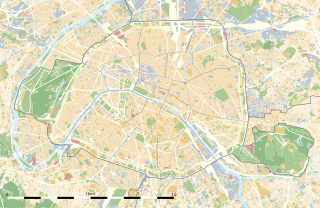
The Canal de l'Ourcq is a 108.1 km (67.2 mi) long canal of in the Île-de-France region with 10 locks. It was built at a width of 3.20 m (10.5 ft) but was enlarged to 3.7 m (12 ft), which permitted use by more pleasure boats. The canal begins at Port-aux-Perches near the village of Troesnes, where it splits from the channeled River Ourcq, and flows to the Bassin de la Villette, where it joins the Canal Saint-Martin. Paris requires 380 000 m3 of water daily for cleaning the sewer system, gutters, and parks. The Canal de l'Ourcq provides about half of the requirement. Since 1983, the waterway has been designated for use by pleasure craft, and its water is designated for non-drinking uses.

The Bassin de la Villette is the largest artificial lake in Paris. It was filled with water on 2 December 1808. Located in the 19th arrondissement of the capital, it links the Canal de l'Ourcq to the Canal Saint-Martin, and it represents one of the elements of the Réseau des Canaux Parisiens, a public-works authority operated by the city. The other components of the network are the Canal de l'Ourcq, the Canal Saint-Denis, the Canal Saint-Martin, and the Bassin de l'Arsenal. Together, these canals and basins extend roughly 130 kilometres (81 mi).

SOCEP Constanţa is a port operator of the Port of Constanţa in Romania. The company was established in 1991 and specializes in stevedoring services and the development of container and steel materials. Having been fully privatized in 1996, Socep is one of the largest port operators in Romania.





















